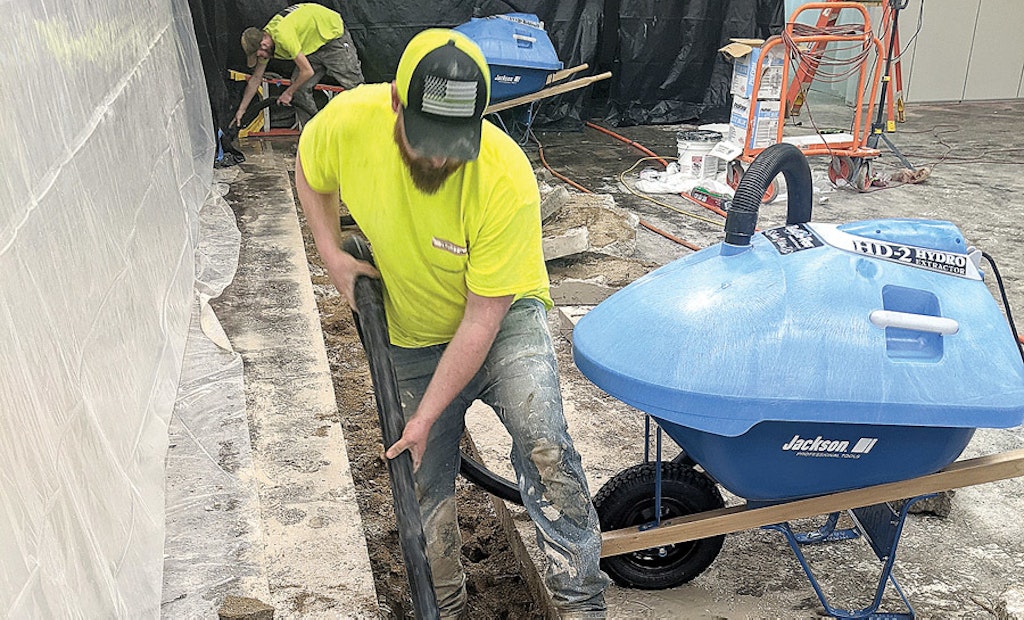
Triple J Plumbing technicians Brad Lowhorn (foreground) and Clayton Mader use Roll-n-Vac portable vacuum machines to suck up sand and spoils from a trench as they prepare to replace a 90-foot sewer lateral in a commercial building.
Interested in Cleaning?
Get Cleaning articles, news and videos right in your inbox! Sign up now.
Cleaning + Get AlertsWhen Terrance Whitehead first heard about the Roll-n-Vac industrial-strength, wet-and-dry vacuum machine from Truebite, the president of Triple J Plumbing immediately sensed it had game-changing potential.
As it turned out, his instincts were correct. The small but powerful machine serves as a mini vacuum truck of sorts that increases productivity, reduces on-the-job injuries and boosts profitability, he says.
“For a small investment, you get a taste for the benefits of vacuuming up materials,” Whitehead says. “It’s a really innovative and ingenious machine.”
Simplicity is the machine’s calling card. It’s essentially just a powerful, industrial-grade electric motor built into a plastic cowling that fits on top of a standard, 6-cubic-foot, construction-grade steel wheelbarrow.
The combination of power and portability makes the Roll-n-Vac a versatile machine. The motor generates 110 cfm of vacuum power; Truebite tests show it can vacuum 200 pounds of sand in three minutes.
Different applications
Triple J uses its two machines for everything from removing mud to quickly revealing curb valves to vacuuming sand, pea gravel and other media from trenches to expose pipes that need repair. Moreover, it’s then easy and convenient to move the vacuumed materials because it’s deposited right into a wheelbarrow, Whitehead says.
“We can run it off a small generator and vacuum up the mud around the valve stem (of a curb box), then take it off the wheelbarrow and put it back on a pickup truck,” he says. “We’ve tried to use a shop vac to do this, but they’re just not designed for that kind of job.”
Based in New Castle, Indiana, about 45 miles east of Indianapolis, Triple J primarily does commercial plumbing along with some residential work. About half of the work is service and repair and the other half is new-construction plumbing, Whitehead says.
The company employs 20 people and runs more than a dozen service vehicles, including a RAM ProMaster 3500 van outfitted with a Spartan Ultimate Urban Warrior water jetter (4,000 psi at 21 gpm); Chevrolet 2500 service vans; a Ford Transit van; and RAM 3500 and 2500 pickup trucks outfitted with Knapheide utility bodies.
Improving productivity
The machine proved its mettle on a recent pipe replacement project.
“We were at an apartment complex where we replaced about 120 feet of 4-inch-diameter cast iron pipe that was about 50 years old and deteriorating badly,” Whitehead says, “but the pipe was under a concrete slab in a bed of pea gravel, so we had cut out a trench in the slab to get at the pipe.”
At that point, company employees would usually remove the pea gravel with shovels, a very labor-intensive and time-consuming process. For starters, unless the trench is cut very wide, which creates more work for employees and adds cost for customers, it’s hard to get a good angle to remove the gravel.
“Second, that pea gravel is always pouring back in while you’re digging,” Whitehead says. “But now we just roll the Roll-n-Vac up to the trench and it does the job. On a very small scale, it’s like having a vacuum truck without spending hundreds of thousands of dollars.”
On some jobs, the Roll-n-Vac even enables work crews to cut narrower trenches because workers don’t need the extra room to maneuver with shovels, which saves time and labor.
Furthermore, using the Roll-n-Vac significantly reduces the odds of employee injuries like back strains, which are common with the torqueing and twisting that occurs when employees shovel out heavy materials like dirt and gravel, he says.
“You’re basically eliminating some manual labor. Digging can be really hard on your back, especially when access (to trenches) is tight. You just stick the hose in the excavation and start vacuuming.”
Wheelbarrow requirements
The Roll-n-Vac retails for $1,824. Features include a float-valve automatic shut-off device, reverse-blowing capability and two 2-inch-diameter hoses, one 10 feet long and the other 20 feet long.
However, the machine doesn’t come with a wheelbarrow, which raises one important caveat: Users must buy a construction-grade steel wheelbarrow. (The least expensive wheelbarrow Truebite recommends is the Jackson 6-cubic-foot model made from industrial-grade steel; it sells for about $130 to $140 at big-box home-improvement centers like Home Depot and Lowes.)
“If you don’t buy the right kind of wheelbarrow, the motor is powerful enough to collapse the wheelbarrow like a tin can,” Whitehead says.
The machine is easy to use. The plastic cowling, which includes a rubber gasket along the bottom rim, easily fits over the top of a wheelbarrow, no clamps required. Then just insert the hose, plug the machine into a standard 110-volt electrical outlet and go to work, he says.
New uses
Whitehead says the company also has used the Roll-n-Vac, originally designed for the pool-cleaning industry, to suck water out of sewer lines and even oil-water separators to make camera inspections easier.
“We’re constantly finding new ways to use it,” he says. “The guys really like them. They improve productivity, make labor less intensive and decrease the chances of our guys damaging lines with shovels.
“They’ve been such a great investment that we’ll probably buy more,” he continues. “I think they’ll sell like hot cakes when people see what they’re capable of doing.”





